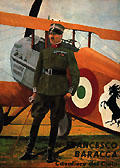Solitude
Click here for a larger map
The 11417 meters (7.1 mile) long public roads in the wooded countryside to the west of Stuttgart were used as the temporary race track Solitude between 1924 and 1965.
After WW II, the Solitude featured several German Motorcycle GPs and non-championship F1 races which attracted huge crowds of up to half a million people!
Legendary pilots like Geoff Duke, John Surtees, Wolfgang Graf Berghe von Trips, Dan Gurney, Jack Brabham or Jim Clark competed there. Hans Herrmann, GP driver for Mercedes-Benz in the 1950s and Le Mans Winner 1970 in a Porsche 917, lives nearby in Magstadt.
The last race on the Solitude circuit was held in 1965 due to several reasons, especially the questionable safety for pilots and spectators, as there are almost no run-off areas, but a lot of trees next to the track. And between the trees and on the hills sides, the spectators were placed. Keeping these crowds under control was a apparently a big problem: The 1962 program has 4 pages of recommendations, rules and laws for spectator behaviour!
The much safer permanent race track in Hockenheim, which had to be rebuilt because of the new Autobahn A61 cut the old triangle circuit there in half, was considered as replacement. Some of the first races in Hockenheim even were named Solitude GP. The new Hockenheim layout was designed by John Hugeholtz, and has some similarities to the Solitude track: after a long and lonesome straight in the forest, the pilots enter a crowded stadium-like section with tight turns, just like it used to be at Büsnau and Schatten.
As it always consisted of public roads, the main part of the track can still be followed today, speed limited to 60 or 80 km/h though.
The oval-shaped "Zeitnehmerhaus" tower on the left of the straight, with Mercedes and Bosch written on it, and the pits on the right side still exist. Also, an "ADAC Verkehrsübungsplatz" (traffic exercise area) is located there in the infield area. Several memorial crosses along the road, usually at the biker-killing armco, remind trespassers of fatal accidents. In 1996, an Oldtimer festival with parading race cars was held on the start/finish straight of the Solitude, including Herrmann's Mercedes W196 and Porsche 917. In 1998, the approx. 600 m long section between Frauenkreuz and Dreispitz was "re-nature-ized" (i.e. new trees were planted) in a trade-off for the forest which was cut down during construction of the new nearby Autobahn Restaurant area "Sindelfinger Wald". It is possible to take a short deviation outside of the forest and rejoin the original track at Dreispitz, but the complete original layout is history now. Protests did not prevent it. On Christmas of 1999, the storm "Lothar" knocked down a lot of trees in France and Germany, and also many trees along the Solitude roads. This changed the impression one has when driving along the roads of the old race track.
Some facts about the Solitude race track: The race track is a public road that was rebuilt in a joint venture of the State of Baden-Württemberg, the State Capital Stuttgart, the County of Leonberg and the Automobil Club section of ADAC-Gau Württemberg as a modern Test and Race Track for Automobiles and Motorcycles in the years 1952 to 56.
Highest Point of race track: 200 meters behind Frauenkreuz at km 3 with 505.92 m
Permanent underpasses for spectators are at:
Lap records (as written in the 1962 progam): Horse and Power



In case someone wonders why a rather familiar looking black and yellow prancing horse sign is placed on the Solitude maps: This is the sign (Coat of Arms) of Stuttgart (which is derived from "Stud Garden" or horse farm). It is called Rößle. Horses were breeded in the Stuttgart valley many centuries ago, but nowadays Stuttgart is more known for its output of horse power. ;-) The Rößle, which is also placed in the center of the Logo of Porsche, is in official use for over 3 centuries. The cavallino rampante of a certain Italian car manufacturer, which is said to have literaturally fallen from sky during World War I were it was used as the sign of a pilot, is used since the 1930s by Enzo Ferrari. |